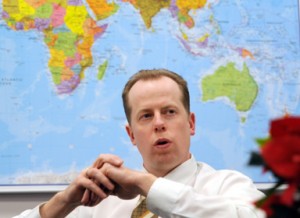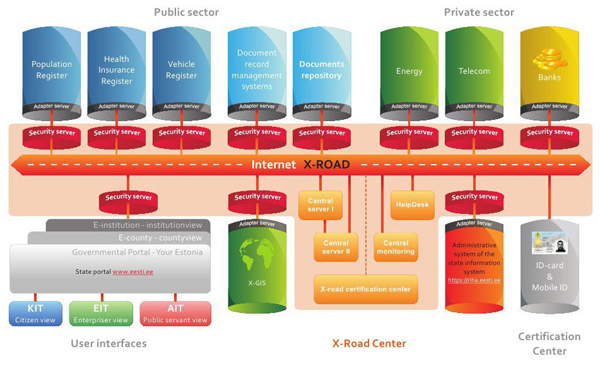Erkki Koort is the Deputy Secretary General for Internal Security Policy at the Estonian Ministry of the Interior. He has extensive experience in internal security field, being the Chairman of the Council of the Estonian Forensic Science Institute and the Chairman of the Coordination Committee to assure the adoption of the single emergency call number 112 in Estonia. He also serves as the chairman of the Council of Master’s Studies of Internal Security at the Estonian Academy of Security Sciences and as the chairman of the counter-terrorism council of Estonian government´s security commission. From 2009 to 2011, Erkki Koort was the head of the working group for evaluating the security risks and developing measures for adopting euro currency in Estonia and a deputy chairman of the cyber security council of the Government´s security commission.
A view from the bridge on some of the challenges and threats experienced and faced by Estonia in its position and leading role as an e-country, based on a digitized society
 A term commonly used to describe Estonia’s emergence as one of the most advanced e-societies in the world is ‘e-Estonia’. It is an incredible success story that grew out of a partnership between a forward-thinking government, a pro-active ICT sector and a switched-on, tech-savvy population. Thanks to this success, Estonians and the Estonian state enjoy a wide range of e-solutions and their nation has become the example for others who wish to follow the same path. They say e- identity is a part of e-country, or more specifically – it is an inevitable prerequisite to e-country or e-society. Is the current e-country an opportunity, a challenge or a threat? Citizens today expect to receive faster services from the state and this creates challenges for the state in providing these services securely. The faster the service and the easier it is to attack, the greater the challenge to the state’s ability to respond quickly.
A term commonly used to describe Estonia’s emergence as one of the most advanced e-societies in the world is ‘e-Estonia’. It is an incredible success story that grew out of a partnership between a forward-thinking government, a pro-active ICT sector and a switched-on, tech-savvy population. Thanks to this success, Estonians and the Estonian state enjoy a wide range of e-solutions and their nation has become the example for others who wish to follow the same path. They say e- identity is a part of e-country, or more specifically – it is an inevitable prerequisite to e-country or e-society. Is the current e-country an opportunity, a challenge or a threat? Citizens today expect to receive faster services from the state and this creates challenges for the state in providing these services securely. The faster the service and the easier it is to attack, the greater the challenge to the state’s ability to respond quickly.
When Estonian political and technical leadership began laying the foundation for e-Estonia, it decided on certain principles:
- decentralization – there is no central database, and every stakeholder, be it a government department, a ministry or a business, gets to choose its own system in its own time.
- interconnectivity – all the elements in the system have to be able to work together smoothly.
- open platform – any institution can use the public key infrastructure.
- open-ended process – as a continuous project to keep growing and improving organically.
The two key ingredients in the infrastructure are the X-Road and e-Identity or e-ID. The X-Road is a critical tool that connects all the decentralized components of the system together. It is the environment that allows the nation’s various databases and registers, both in the public and private sector, to link up and operate in harmony no matter what platform they use. eID is the nationally standardized system for verifying a person’s identity in an online environment. It opens the door to all secure e-services while maintaining the highest level of security and trust.
Other systems have since been linked, thanks to these. But the Estonian government did not create programming resources – it acted as a smart purchaser. The licenses belong to the taxpayer, but the solutions were created by private companies. That way costs were reduced, while flexibility was maintained.
In this interview, Erkki Koort, Deputy Secretary General for Internal Security Policy at the Ministry of the Interior of Estonia, outlines some of these challenges and Estonia’s position and leading role in establishing technologies, which underpin the development of identification systems and data.
Estonia is seen as a thought leader in ID and has taken up the mantle in regard the whole use of digital data. Why is this?
 I can proudly say that we are a leader in this. One of the reasons is that after the Soviet occupation our country developed so quickly and we did not have to go through all the steps that Western Europe needed to make in terms of becoming a digital society, So we just went to the next level and this is what helps us be so innovative. Also close cooperation with the Scandinavian countries has been and is a key element of that.
I can proudly say that we are a leader in this. One of the reasons is that after the Soviet occupation our country developed so quickly and we did not have to go through all the steps that Western Europe needed to make in terms of becoming a digital society, So we just went to the next level and this is what helps us be so innovative. Also close cooperation with the Scandinavian countries has been and is a key element of that.
Given the strong focus on technological development in Estonia, does the country have a strong academic base in technical development and skills?
Yes, we have a good education system at this level however technology can only be implemented if you have an idea first. So it is most important to develop an idea as it will always be possible to find engineers and smart people to help you to implement it. In this regard we have developed the e-country, which is Estonia.
We have had e-government in place for 15 years and it is already a history lesson in our schools. This means we have a paperless government with all its benefits, but on the other hand this can create threats that need to be constantly monitored. For example, in 2007 we were under a cyber attack – in fact, Estonia was one of the first countries in the world to be attacked in this way. But we managed to come out stronger and with the realization that should the ‘e’ be removed from an e country, there is still a need to act like a country in any event in terms of having the correct protections and controls in place as in any governmental system.
Other threats include a desire to find an e-solution for everything – some things are best left on paper; the emergence of the opinion that e-solutions do not require officials; the possibility to use false identities from all over the world. In addition, faster lifestyle and social communication can equal faster crimes.
What are some of the opportunities and benefits that have been derived from this evolution?
Threats do arise, but are far outweighed by the opportunities. For example, our elections are all held online and in Estonia’s 2011 elections we had people from 105 countries who participated in our elections – bringing citizens who are based all over the world into the process.
So e-Estonia means voting in elections from the comfort of your own living room, filing your income tax return in just five minutes, signing a legally-binding contract over the Internet, from anywhere in the world, via your mobile phone. These are just a few of the services that Estonians take advantage of on a regular basis. For their part, entrepreneurs can register businesses in as little 18 minutes, check vital company, property and legal records online, and even integrate their own secure services with the ones offered by the state. Also Estonia’s e-solutions have resulted in an unprecedented level of transparency and accessibility in government offering safe, convenient and flexible exchange of private, government and corporate data.
Are there specific future challenges that will be brought by this digital society and infrastructure?
The e-Estonia digital society is made possible largely due to its infrastructure. Instead of developing a single, all-encompassing central system, Estonia created an open, decentralized system that links together various services and databases. The flexibility provided by this open set-up has allowed new components of the digital society to be developed and added through the years. It is that power to expand that has allowed Estonia to grow into one of Europe’s success stories of the last decade.
So while there are no borders in cyber world, the importance of the size of a country is continuously diminishing and even the geographical location of the country is less important. This means the larger the e-country, the greater its influence in the future, creating the possibility of efficient cooperation between countries.

